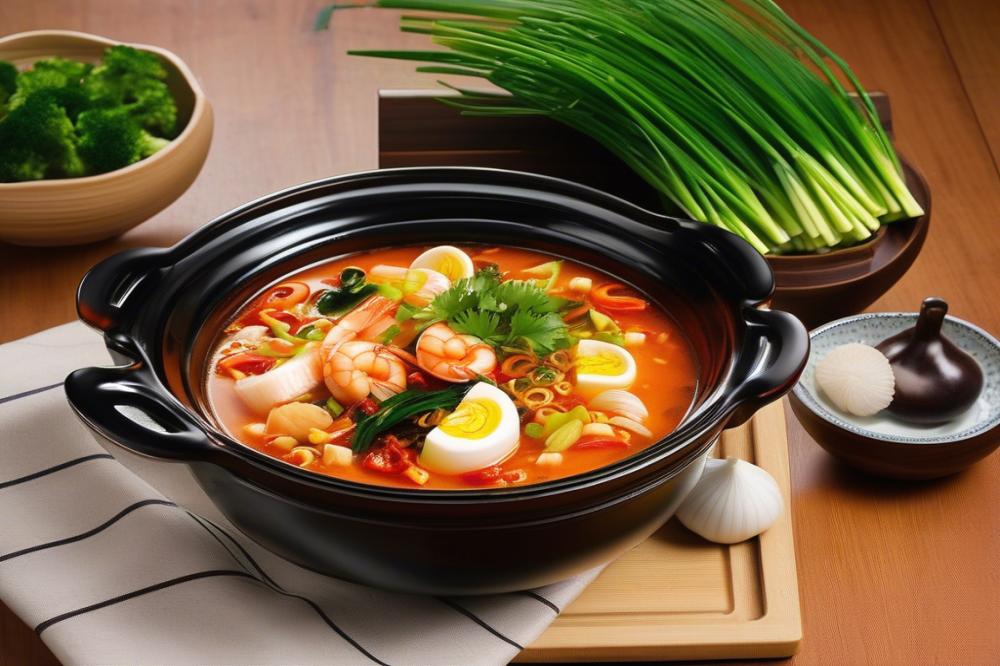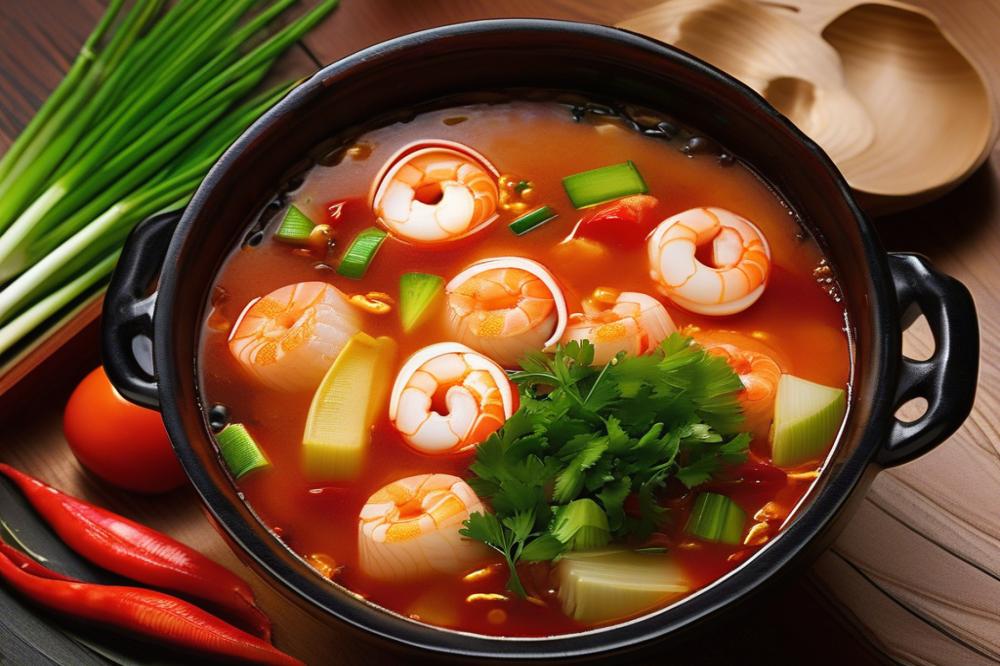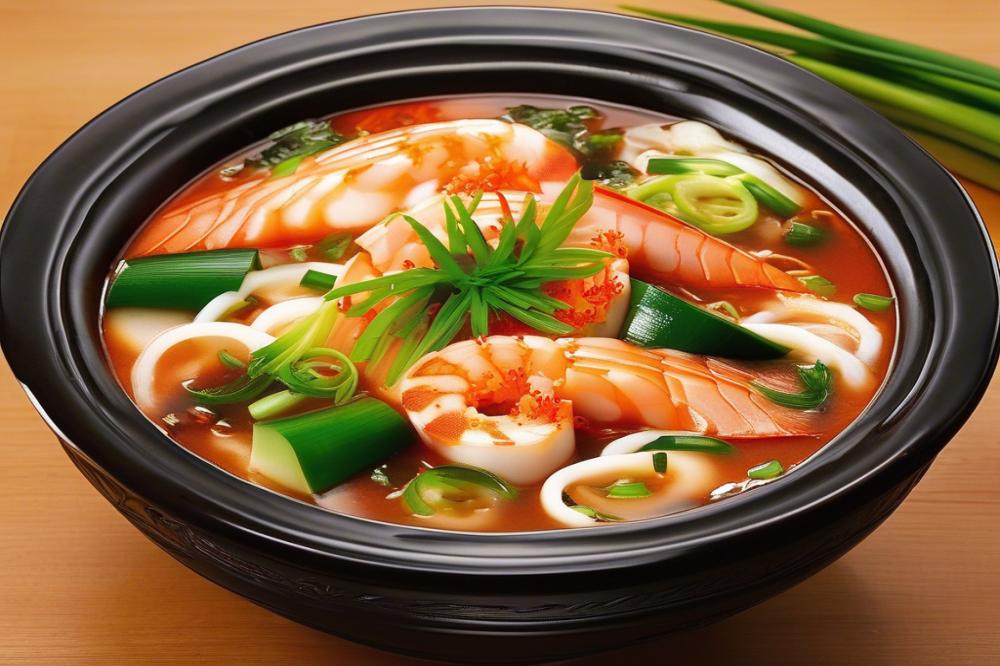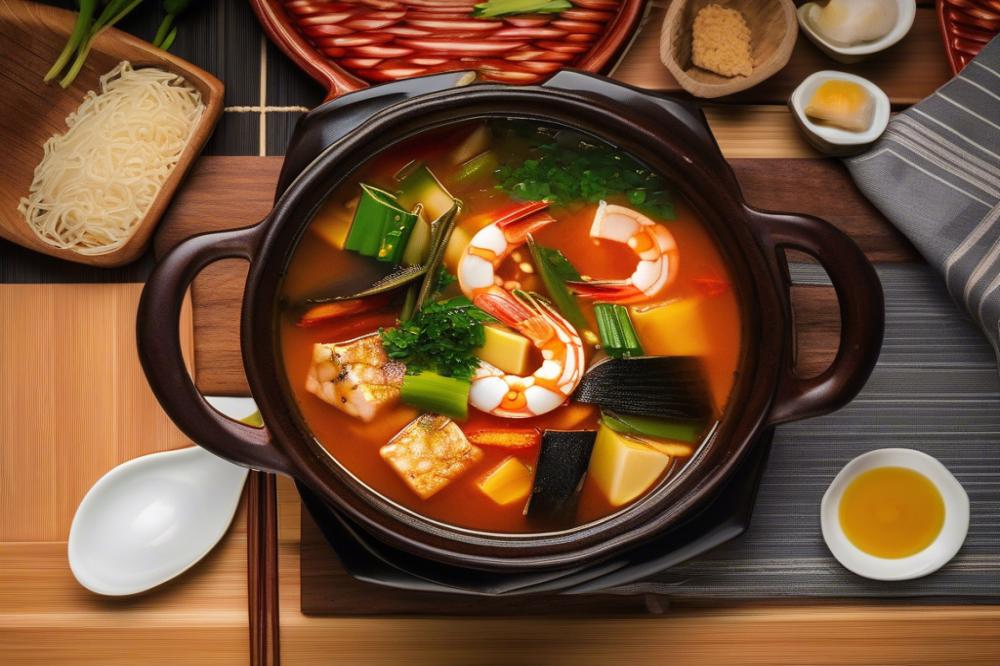Introduction
Sundubu Jjigae is a cherished classic in Korean cuisine. This flavorful dish consists of a spicy tofu stew that warms the soul. Every bite evokes the essence of home and tradition. Recognized for its bold flavors, this stew is a popular choice among many. It is often served in a bubbling hot stone pot, adding to its rustic charm.
Significance runs deep in the Korean culinary world. This dish embodies comfort food, providing nourishment during cold days or in times of need. The combination of silky tofu, aromatic gochujang, and a variety of vegetables creates a delightful experience. It is not merely a meal, but a heartfelt dish that brings families together.
A variation that many people adore is the seafood stew. This version incorporates fresh clams, succulent shrimp, and tender fish. Each ingredient adds depth and a unique taste to the already rich broth. The addition of these sea treasures enhances both flavor and nutrition while providing a delightful surprise with each spoonful.
This spicy soup is known for its bold and comforting flavor profile. The heat from chili paste complements the soft, warm tofu perfectly. Vegetables add a crunch and brightness to the dish, balancing the savoriness of the miso. Each bite is a dance of flavors that captivates the palate. The aroma alone can make anyone eager to dig in. Cooking this dish not only satisfies hunger but also the heart.
What is Sundubu Jjigae?

Sundubu Jjigae is a popular tofu stew in Korean cuisine. It features silken tofu, which has a delicate texture. This dish is often served hot and is known for its spicy soup base. The warmth and spice make it a comforting choice for many.
Key ingredients include clams, shrimp, and fish. Fresh seafood adds a flavorful element to the dish. Other important components are gochujang, a spicy red pepper paste, and miso, which deepens the savory taste. Various vegetables, like zucchini and mushrooms, often join the mix, providing additional flavor and nutrition.
Culturally, Sundubu Jjigae holds significance in Korea. It is often enjoyed during family gatherings or special occasions. Many people associate it with memories of home-cooked meals shared with loved ones. This stew is also famous for its versatility. Adjusting ingredient amounts or types allows for personalized versions of this delightful comfort food.
Some enjoy it with rice, while others appreciate adding extra spice for a bolder taste. Friends and family often gather to savor this dish, making it a communal experience. Its ability to satisfy hunger and warm hearts is what truly makes it special in Korean tradition.
Ingredients List

To prepare an authentic Sundubu Jjigae with a seafood twist, gather the following ingredients. Start with 300 grams of silken tofu. This ingredient adds a silky texture to the dish. Next, you will need a seafood mix weighing around 300 grams. This should include tender clams, juicy shrimp, and delicate white fish.
One medium-sized onion provides a solid base for flavor. It contributes sweetness and depth. Two stalks of green onion will add a fresh, vibrant touch. They enhance both the look and taste of the spicy soup. Garlic is essential, so grab three cloves. Minced garlic brings a strong aromatic quality that complements the other ingredients very well.
For seasoning, gochujang is a key player. You will need two tablespoons of this spicy red pepper paste, which gives the stew its signature heat. Miso paste, with its savory notes, should be included as well. One tablespoon of miso will bring additional richness to the flavors.
Two cups of vegetable broth will serve as the soup’s base. This is crucial for creating a warm and inviting liquid. Using vegetable broth ensures that the dish remains comforting while bringing out the flavors of the vegetables and seafood. Lastly, you’ll need sesame oil, about one tablespoon. This will add a nutty richness. Season with salt and pepper to taste, adjusting to your preference.
Each ingredient plays a role in making this tofu stew a beloved dish in Korean cuisine. The combination of seafood, spices, and vegetables results in a hearty meal. Prepare these ingredients, and you will be on your way to a comforting dish that warms both body and soul.
Nutritional Information

Tofu serves as a fantastic base for this Korean cuisine staple. It is high in protein while being low in calories, making it a popular choice for health-conscious eaters. This soy product not only enhances texture but also packs a nutritious punch that complements the dish.
Seafood adds a delightful twist to the recipe. Ingredients like clams, shrimp, and fish bring essential omega-3 fatty acids to the table. These healthy fats promote heart health and provide valuable vitamins and minerals that benefit the body.
Vegetables play a crucial role in this spicy soup. They contribute fiber, which aids digestion, alongside a variety of vitamins and antioxidants. Greens like spinach and bok choy, or mushrooms, enhance both flavor and nutrient density, helping the dish feel more balanced.
Gochujang brings an iconic heat to the stew. This red chili paste is not only flavorful but also offers health benefits, including potential anti-inflammatory effects. It can transform an ordinary meal into a comforting experience with its unique flavor profile.
Miso also finds its place in the recipe. This fermented soybean paste is rich in probiotics, which are great for gut health. Including miso not only elevates the taste but contributes to a well-rounded, nourishing bowl of comfort food that warms the soul.
Cooking Instructions

To prepare your seafood tofu stew, start by heating sesame oil in a sturdy pot over medium heat. This oil adds a distinct flavor that truly enhances the dish. Once warm, toss in chopped onions and minced garlic. Sauté these until they become fragrant. You want them to become a bit soft but not browned.
Next, mix in gochujang and a spoonful of miso paste. Stir well to combine these ingredients, which will create a rich and flavorful base for your spicy soup. The heat from gochujang adds depth, while the miso brings in umami notes that are essential in Korean cuisine.
Now, pour in a good amount of vegetable broth. Bring this mixture to a gentle simmer. The broth will marry the flavors from the previous ingredients. After it reaches a simmering point, carefully add your choice of seafood. This could include fresh clams, shrimp, and fish. Cook them until they are tender. This usually takes only a few minutes, so keep an eye on them!
It’s time to gently add silken tofu into the pot. You will want to break it into large pieces, as this will create a comforting texture. Let the stew simmer for a little while longer. This allows the tofu to soak up all the wonderful flavors from the broth.
Season the dish with salt and pepper to taste. Adjust it according to your preference. Finally, before serving, sprinkle chopped green onions on top. They not only add color but also a fresh crunch that makes the stew even more enjoyable. Serve this delightful dish hot, and enjoy a warm taste of comfort food right in your bowl.
Serving Suggestions
To serve a delightful bowl of spicy soup, begin by ladling the hot dish into individual bowls. This presentation adds a personal touch. Always place the bowl on a small saucer to catch any drips. For a visual pop, sprinkle some chopped green onions or sesame seeds on top.
Pairing Sundubu Jjigae with suitable side dishes heightens the experience. Kimchi is a classic choice, providing a crunchy, spicy contrast. Another great option is pickled radish, which cleanses the palate between bites. Try adding seasoned spinach or a simple salad as well for a refreshing balance.
Traditional Serving Style and Accompanying Rice
In Korean cuisine, meals are often enjoyed family-style. Serving the stew in a communal pot allows everyone to enjoy it together. Alongside, serve a bowl of fluffy white rice. The rice complements the tofu stew beautifully, absorbing the rich flavors. Dip a spoonful of rice into the spicy broth, or mix it directly into the soup.
Traditionally, miso is used in some variations of this dish, enhancing its depth. Different kinds of seafood, including clams, shrimp, and fish, create a wonderful mix of flavors. These ingredients provide various textures and tastes, making each bite interesting. They also bring a sense of warmth and comfort to the meal.
Always remember to adjust the spice level. If you enjoy heat, add gochujang directly into the stew or as a condiment on the side. Guests can customize their experience by adding more or less of this Korean red pepper paste.
Variations and Substitutions
Sundubu Jjigae can easily transform based on the ingredients you choose. Various types of seafood work well in this spicy soup. For example, clams add a briny taste that complements the dish. Shrimp brings a bit of sweetness and cooks quickly. Additionally, some people enjoy adding chunks of white fish for a different texture. Whatever you choose, fresh ingredients can make a significant difference.
Vegetarians and vegans have their own options. Instead of seafood, you might use mushrooms, such as shiitake or enoki. These can provide a savory, umami flavor. Furthermore, using a plant-based miso instead of the fish broth can create a rich base for your stew. Tofu remains a fantastic option, as it absorbs the flavors of the broth well. You could also toss in seasonal vegetables, like zucchini or spinach, to enhance the color and nutrition of your meal.
Adjusting the spice levels can cater to various taste preferences. If you enjoy the heat, increase the amount of gochujang or add some red pepper flakes. For those who prefer milder flavors, you can start with a small amount and add more as needed. Some people like to balance spiciness with a little sweetness, perhaps by adding a touch of sugar or sweet potato. Always remember to taste as you cook, allowing the flavors to develop fully.
Wrapping Up the Comfort of Tofu Stew
Sundubu Jjigae brings a wonderful warmth to any meal. This comforting dish combines soft tofu with fresh seafood, creating a satisfying bowl that feels like a hug on a cold day. Flavors mingle harmoniously, filling your kitchen with a delightful aroma as it cooks. Each spoonful delivers warmth, perfect for sharing with family or friends.
Trying to cook this dish at home can be a rewarding experience. Gather your ingredients and follow the steps. Don’t worry if it doesn’t turn out perfect the first time; cooking is a journey. Each attempt will teach you more about the flavors and techniques. Enjoy the process, and soon you will have your own delicious version of this popular tofu stew.
Korean cuisine deserves recognition for its rich flavors and diverse ingredients. Cooking with fresh ingredients enhances the experience and helps you appreciate the simple joys of creating a meal. Dive into this culinary adventure and share the love of food with those around you. Each dish is a story waiting to be told, and Sundubu Jjigae is just one wonderful chapter in the beautiful world of Korean cooking.



